
The notion of what it means to be a giver varies for each person. Adam Grant, author of Give and Take, defines three broad types of people in society, which include Givers, Matchers and Takers.
Givers, Matchers and Takers
Givers are people who help others with no strings attached. Matchers help others but want to know what's in it for them based on a quid pro quo mentality. Takers need the scale to tip towards their self-interest.

Who are the least successful people?
Of the three reciprocity styles, the one that represents the least successful group of people are, selfless givers. Selfless givers often burnout and suffer from exhaustion by putting others first and ignoring their own needs. Grant cites a study from the Journal of Personality and Social Psychology, that concludes:
"When compared to takers, givers earn 14 per cent less money, have twice the risk of becoming victims of crimes, and are judged as 22 percent less powerful and dominant."
Who are the most successful people?
Grant, a psychology professor, studies givers, matchers and takers. After reviewing the data, the most successful people turn out to also be givers. Grant says givers hold the top and bottom positions on the success ladder in society. Why are givers the least and most successful people in society?
Grant uses the term "otherish" to describe successful givers. They focus on win-win outcomes. They don't burnout because they take care of themselves and create boundaries. According to Grant, studies show the average successful giver performs about 30 per cent better than matchers and 68 per cent better than takers over time.
Is there a connection between individual and collective success?
Rick Brown is the National Channel Manager for NetApp in Canada. NetApp is a technology company with more than 12,000 employees in 150 countries. Rick is often asked why he dedicates so much time volunteering to various causes. He responds by saying, "It is the NetApp thing to do". Rick describes a company culture that prides itself on rewarding employees who give back by volunteering for various local charities of their choice.

One such charity that got the NetApp team in New York City excited about getting involved in was the St. Baldrick's Foundation. It is a volunteer-driven charity committed to funding research for childhood cancer treatments, so that survivors can receive kinder and gentler medications thus ensuring that they can lead long and healthy lives. Often the treatments are more damaging to a patient than the cancer itself. The excitement and buzz from the New York City team led to the rest of the company following in other cities and countries. Every year, NetApp employees in Canada, participate by shaving their heads to raise money for Childhood Cancer Canada.
Why does volunteering matter?
Peter Drucker, author of Managing Oneself (Harvard Business Review, 2008), says there are many benefits to volunteering:
"You have responsibility, you see results, and you quickly learn what your values are. There is no better way to understand your strengths and discover where you belong than to volunteer in a nonprofit."
Rick is a giver and sees many benefits to volunteering. Volunteering for causes aligns with his values and reminds him about what is important. For him, an individual being in good health matters most. His involvement with the charity put him in touch with families whose children suffer from one condition or another.
Rick's need to be a giver resonates with his own personal story. His son, now 19 years old, was born with a defect in his aortic valve. Every parent goes through the highs and lows of being in and out of the healthcare system for an ailing child. After many years, Rick's son recently underwent successful open-heart surgery and is recovering. Rick recognizes that he is blessed because his son should be able to live a long, healthy and normal life. This is not the case for kids with cancer and other illnesses.
When Rick says, "It is the NetApp thing to do", it means the personal values of employees align with their company's values, specifically around giving back in the community.
The 100 hour rule
Grant says that the magic number when it comes to volunteering is one hundred hours per year or two hours a week. Research shows that if people volunteer about two hours a week, their happiness, satisfaction, and self-esteem increase a year later. This type of giving allows them to make a meaningful contribution without jeopardizing other commitments they may have during the week.
Perhaps this is one reason top ranked employers like NetApp, Salesforce, VMWare, and Novo Nordisk offer 40 to 100 hours of paid time off to volunteer at schools and nonprofit organizations of their choice. Employees who are able to give and make a difference to their favorite causes feel energized.
Be Happier by chunking your giving time
Grant says the happiest givers are people who chunk or batch their giving time together. He contrasts "chunkers" with "sprinklers." Chunkers are people who create a dedicated time slot for interacting, planning and helping others. Sprinklers spread out their giving across the week evenly. In various studies, people who batch their giving together are happier than people who sprinkle giving throughout the week.
In one study, Grant says two groups of people performed five random acts of kindness every week for six weeks. One group "sprinkled" or spread out giving a little bit each day. Another group "chunked" their giving into a single day each week. By the end of the six weeks, the happiness levels of chunkers jumped while it was negligible for the sprinklers group. It seems that volunteering in chunks in focused and intense periods is a strategy that successful givers use -- both individuals and companies alike.
In Summary
The benefits of being a giver are overall positive when we take care of ourselves first. Givers are happier, more successful align themselves with purposeful organizations.
ALSO ON HUFFPOST:
